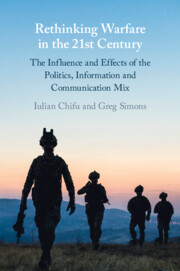 Rethinking Warfare in the 21st Century
Rethinking Warfare in the 21st Century Published online by Cambridge University Press: 29 June 2023
The chapter seeks to lay out the conceptual and practical foundations of information warfare in the twenty-first century. Different concepts are identified and defined, together with how they affect and influence the information and cognitive realms of global audiences. The evolution and development of information warfare is identified and analysed. In addition to establishing why the problem of information warfare exists, and at this point in time, some proposals are explored as to how to set about addressing the problem.
To save this book to your Kindle, first ensure [email protected] is added to your Approved Personal Document E-mail List under your Personal Document Settings on the Manage Your Content and Devices page of your Amazon account. Then enter the ‘name’ part of your Kindle email address below. Find out more about saving to your Kindle.
Note you can select to save to either the @free.kindle.com or @kindle.com variations. ‘@free.kindle.com’ emails are free but can only be saved to your device when it is connected to wi-fi. ‘@kindle.com’ emails can be delivered even when you are not connected to wi-fi, but note that service fees apply.
Find out more about the Kindle Personal Document Service.
To save content items to your account, please confirm that you agree to abide by our usage policies. If this is the first time you use this feature, you will be asked to authorise Cambridge Core to connect with your account. Find out more about saving content to Dropbox.
To save content items to your account, please confirm that you agree to abide by our usage policies. If this is the first time you use this feature, you will be asked to authorise Cambridge Core to connect with your account. Find out more about saving content to Google Drive.